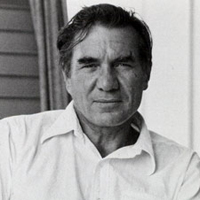Galway Kinnell - Biography and Works
Galway Kinnell is an American poet and novelist known for his distinctly 'personal' poetic voice. Kinnell's poetry stresses the importance of daily experience; it also focuses on the physical aspects of existence and illustrates the intimate ties between the human and animal world. Kinnell was born in Providence, Rhode Island.

Galway Kinnell (1927-2014)
He began writing poetry seriously while attending Princeton University, where he was influenced and encouraged by American poets W.S. Merwin and Charles G. Bell. Kinnell served in the United Sates Navy from 1945 to 1946 and then returned to Princeton, receiving his B.A. degree in 1948. After earning an M.A. degree from the University of Rochester in 1949, he taught in various places, including New York State, France, Iran, and Australia. During the 1960s Kinnell was active in African American voter registration drives in the American South and in demonstrations against the Vietnam War. To many critics, Kinnell’s first volume of poetry, What A Kingdom It Was (1960), helped signal a transition in American poetry from the conventional verse of the 1950s to the less restrained forms and themes of the 1960s. Kinnell marked this change with his graphic and powerful use of language and images to describe everyday events.
Kinnell first received widespread recognition with Body Rags (1968), in which he examines the human and animal worlds in an attempt to understand the more primitive aspects of humanity. Imperfect Thirst (1994), Kinnell’s 12th collection of poetry, continues in the vein of his earlier works, attempting to articulate the relationship between people and nature. Kinnell marked a new direction away from formal modernism that led to deep image poetry (of the late seventies), a name given to the work of Robert Bly, James Wright, Galway Kninell, and others who were born in the 1920s. These poets rejected what they saws as capitalism’s sterile public facade and turned to what Bly called a “deep inwardness,” looking for internal spiritual sources that lie deep within the self and taking leaps into the unconscious to retrieve mysterious, disturbing, and often healing images. Kinnell also marked the “explosive new plurality” that prospered in American poetry from about 1960. Vigorous and unbridled variety marked the poetic scene, Galway Kinnell divides his time between Vermont and New York City, where he is the Erich Maria Remarque Professor of Creative Writing at New York University. He is currently a Chancellor of The Academy of American Poets.
The poems of his first volume were informed by a traditional Christian sensibility. However, while retaining a sacramental dimension to his later works, burrow fiercely into the self away from traditional source of religious authority or even conventional notions of personality. If you could keep going deeper and deeper’, he has said, ‘you’d finally not be a person…. You’d be a blade of grass or ultimately perhaps a stone. And if a stone could read, poetry would speak for itself. Kinnell often refers to a transformation power that gives radiance to the gross life of the flesh. His poetry indeed searches for a deeply rooted spirituality, grounded in whippoorwills and deer dung and the flesh of bears. He plumbs the unconscious for deep images and universal patterns that contains the last traces of a primitive way of life. He portrays the landscape as if immersed in dreams he consciously seek to shatter waking states and expose the terror a beauty which lurks within the unconscious. Kinnell began writing in a highly formal style, but subsequently moved to a freer verse that corresponds to “the rhythm of what’s being said.”
What a Kingdom It Was from which “The First Song” is taken, was Kinnell’s first published book of poems (1960). Signaling decisive changes in the mood and character of American poetry as it departed from the witty, pseudo-mythic verse, apparently written to critical prescription, of the 1960s”. Many of the poems deal with a sense of transgression or less, which leads to a need for propitiation or reconciliation. In “First Song” three boys transform corn stalks into violins and awaken in them a sense of aesthetic awareness coupled with a loss of innocence. The transcendence accomplished through the intercession of Kinnell’s work as a whole, just as is the double awareness in the final line of the darkness and that tie at the core of life.
Cite this Page!
Shrestha, Roma. "Galway Kinnell - Biography and Works." BachelorandMaster, 9 Nov. 2013, bachelorandmaster.com/biography/galway-kinnell.html.
